BROWSE BY POPULARITY
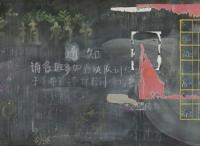 Do you remember your classroom blackboard? Chen Jiao takes us back to our first years of school: a glimpse into the world of language and letters, equations and charts. With layers of colorful accents, the childlike trees and found paper, she refers to her own childhood in southern China. The grey wash over the board mimics the grey sky of her industrial town; the trees evoke the trails where she discovered new pathways on long walks. The characters on the board remind the students of their post-Cultural Revolution identities as coexisting workers, yet the yellow chart creates a rating system for a spectrum of students. It is the paradox of Chinese education: how do you distinguish yourself when you must also live as one small part to a whole? No matter where you are from, Blackboard – Jintang Middle School, by Chen Jiao touches on the universalism of learning and its ability to shape both a society’s and child’s memories.
Do you remember your classroom blackboard? Chen Jiao takes us back to our first years of school: a glimpse into the world of language and letters, equations and charts. With layers of colorful accents, the childlike trees and found paper, she refers to her own childhood in southern China. The grey wash over the board mimics the grey sky of her industrial town; the trees evoke the trails where she discovered new pathways on long walks. The characters on the board remind the students of their post-Cultural Revolution identities as coexisting workers, yet the yellow chart creates a rating system for a spectrum of students. It is the paradox of Chinese education: how do you distinguish yourself when you must also live as one small part to a whole? No matter where you are from, Blackboard – Jintang Middle School, by Chen Jiao touches on the universalism of learning and its ability to shape both a society’s and child’s memories.
Click on the artwork for more information-
$35.00
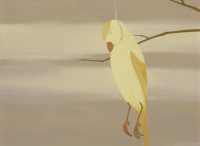 Disquieting in both its graphic content and perverse visual appeal, this work provides the conflicting experience of drawing you in while turning your stomach. A skillfully depicted, brightly colored songbird dangles lifelessly from a miniature noose strung on a bare, spindly branch. The backdrop of pale, drab clouds set against a muted sky give the unsettling feeling of either an execution at dawn or a polluted wasteland. The composition and painting style provide a disturbing variation on Northern Song (960-1126) bird-and-flower painting, which traditionally presented lively birds perched on elegant floral branches against a background of plain taupe silk. In Lili's reinterpretation, all the leaves have wilted and fallen away, and the bird has opted to take its own life. Although dramatic, the work is instilled with a sense of peace and surrender.
Disquieting in both its graphic content and perverse visual appeal, this work provides the conflicting experience of drawing you in while turning your stomach. A skillfully depicted, brightly colored songbird dangles lifelessly from a miniature noose strung on a bare, spindly branch. The backdrop of pale, drab clouds set against a muted sky give the unsettling feeling of either an execution at dawn or a polluted wasteland. The composition and painting style provide a disturbing variation on Northern Song (960-1126) bird-and-flower painting, which traditionally presented lively birds perched on elegant floral branches against a background of plain taupe silk. In Lili's reinterpretation, all the leaves have wilted and fallen away, and the bird has opted to take its own life. Although dramatic, the work is instilled with a sense of peace and surrender.
Click on the artwork for more information-
$35.00
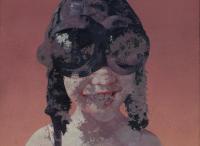 A toothy grin and great googly eyes. A child smiles at you, and the aviator's cap on her head is both absurd and whimsical, a joke the child knowingly shares with you the observer. Children are a frequent theme in Guo Jin's work, meditations upon pure joy and unadultered idealism. But against the context of modern China, the commentary takes on deeper, critical tones, asking if society's innocence has been lost or if naivety remains; if our worldview is youthful with its eyes full of opportunity, or blinded and obscurded by play-acting and make-believe.
A toothy grin and great googly eyes. A child smiles at you, and the aviator's cap on her head is both absurd and whimsical, a joke the child knowingly shares with you the observer. Children are a frequent theme in Guo Jin's work, meditations upon pure joy and unadultered idealism. But against the context of modern China, the commentary takes on deeper, critical tones, asking if society's innocence has been lost or if naivety remains; if our worldview is youthful with its eyes full of opportunity, or blinded and obscurded by play-acting and make-believe.
Click on the artwork for more information-
$35.00
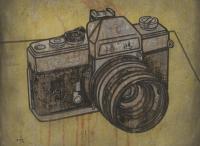 He Jian is notable for his distinctive amalgamation of ancient and contemporary Chinese culture. Rather than painting in oil like most of his contemporaries, he uses rice paper, dry pigment, and binder as his media. He strategically layers and manipulates his paints to take on the timeworn quality of the 14th century Yuan Dynasty frescoes at the Yong Le Temple in Shanxi Province. He Jian uses this distinctive new-old, antiquated style to present a wide range of quotidian subject matter. Although many of his works portray figural groups engaged in activities characteristic of modern Chinese life, in this series He Jian directs his focus towards utilitarian objects that signaled China’s shift towards a consumer culture. Seagull, the first camera maker in China founded in 1958, released the DF series seen here in 1964, and today, its image instantly conjures nostalgia for the time period. He Jian's painting melds the stylistics of classical China with a subject that heralds its recent history in paintings that negotiate the separate but continuous histories that inform China's present.
He Jian is notable for his distinctive amalgamation of ancient and contemporary Chinese culture. Rather than painting in oil like most of his contemporaries, he uses rice paper, dry pigment, and binder as his media. He strategically layers and manipulates his paints to take on the timeworn quality of the 14th century Yuan Dynasty frescoes at the Yong Le Temple in Shanxi Province. He Jian uses this distinctive new-old, antiquated style to present a wide range of quotidian subject matter. Although many of his works portray figural groups engaged in activities characteristic of modern Chinese life, in this series He Jian directs his focus towards utilitarian objects that signaled China’s shift towards a consumer culture. Seagull, the first camera maker in China founded in 1958, released the DF series seen here in 1964, and today, its image instantly conjures nostalgia for the time period. He Jian's painting melds the stylistics of classical China with a subject that heralds its recent history in paintings that negotiate the separate but continuous histories that inform China's present.
Click on the artwork for more information-
$35.00
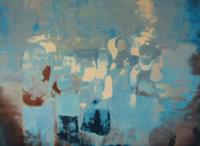 The youthful figures from Exponential Repetitions of Visual Readings: Play by Wang Chunli, are nostalgic and almost ghost-like, their forms barely fleshed out in a palette of blue, brown, and beige. Wang Chunli's painting technique is heavily mediated by the act of facsimile, making physical and digital copies of images until they are reduced to their essence. His painting style evokes the quality of memory; shapes shift and shimmer in an ether tempered by blue melancholy. The subjects are indistinct, as are the specifics of their presence, and it is perhaps the emotional tones of the painting that register most clearly.
The youthful figures from Exponential Repetitions of Visual Readings: Play by Wang Chunli, are nostalgic and almost ghost-like, their forms barely fleshed out in a palette of blue, brown, and beige. Wang Chunli's painting technique is heavily mediated by the act of facsimile, making physical and digital copies of images until they are reduced to their essence. His painting style evokes the quality of memory; shapes shift and shimmer in an ether tempered by blue melancholy. The subjects are indistinct, as are the specifics of their presence, and it is perhaps the emotional tones of the painting that register most clearly.
Click on the artwork for more information-
$35.00
 Chen Shijun's distinctive painting style mediates between digital and physical images. The Online Encyclopedia series, for example, takes prosaic images found while browsing online as its source material, and then interprets it through through heavy texturing and a nostalgic palette, converting the raw digital image into a final product with an exceptional sense of physicality. Online Encyclopedia: True Facts No. 2 takes as its source a digital photograph of man's 1960s landing on the moon. The photograph bears the watermark of Xinhua, the official news agency of the Chinese government. Chen Shijun highlights the conflict between battling narratives from the United States, responsible for the landing, and Xinhua, responsible for narrating the story to a Chinese audience. The title of the work, True Facts (2) is a question asking what is reality, how is it represented, and who tells it?
Chen Shijun's distinctive painting style mediates between digital and physical images. The Online Encyclopedia series, for example, takes prosaic images found while browsing online as its source material, and then interprets it through through heavy texturing and a nostalgic palette, converting the raw digital image into a final product with an exceptional sense of physicality. Online Encyclopedia: True Facts No. 2 takes as its source a digital photograph of man's 1960s landing on the moon. The photograph bears the watermark of Xinhua, the official news agency of the Chinese government. Chen Shijun highlights the conflict between battling narratives from the United States, responsible for the landing, and Xinhua, responsible for narrating the story to a Chinese audience. The title of the work, True Facts (2) is a question asking what is reality, how is it represented, and who tells it?
Click on the artwork for more information-
$35.00
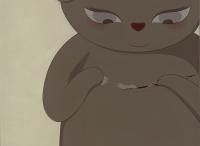 As the title of the work implies, this teddy bear with a heart-shaped nose and a coy smile appears to be quite peaceful. Upon closer examination, however, a more sinister and disturbing scene unfolds before us. We quickly discover that this cuddly creature is in the midst of pulling the stuffing from its chest. Even more unsettling is the apparent relish with which this act is being undertaken. The bear's focused gaze, rosy cheeks and sly grin all illustrate a degree of amusement. An additional level of tension and disquiet is achieved with the subtle drops of ruby red along the mouth and dotting its paws. This detail further emphasizes the surreal elements of the composition, as this seemingly living, breathing stuffed bear blushes with pleasure.
As the title of the work implies, this teddy bear with a heart-shaped nose and a coy smile appears to be quite peaceful. Upon closer examination, however, a more sinister and disturbing scene unfolds before us. We quickly discover that this cuddly creature is in the midst of pulling the stuffing from its chest. Even more unsettling is the apparent relish with which this act is being undertaken. The bear's focused gaze, rosy cheeks and sly grin all illustrate a degree of amusement. An additional level of tension and disquiet is achieved with the subtle drops of ruby red along the mouth and dotting its paws. This detail further emphasizes the surreal elements of the composition, as this seemingly living, breathing stuffed bear blushes with pleasure.
Click on the artwork for more information-
$35.00
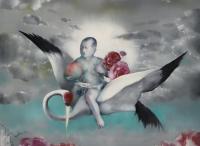 Luo Fahui is part of the generation of artists who studied fine arts shortly after the Cultural Revolution (1966-1976). His oil paintings, which are characterized by surreal, pearly gray compositions, punctuated by bright splashes of crimson and turquoise, address themes of desire, isolation and violence.
Luo Fahui is part of the generation of artists who studied fine arts shortly after the Cultural Revolution (1966-1976). His oil paintings, which are characterized by surreal, pearly gray compositions, punctuated by bright splashes of crimson and turquoise, address themes of desire, isolation and violence.
The title of this work refers to ancient poems of mystical excursion, in which a Daoist master is carried off to the realm of the Immortals. These stories were sometimes fantasies of poets who dreamt of escaping conventional society. In Chinese mythology, the Immortals’ preferred mode of transportation was a fantastical red-crowned crane; mortals who achieved immortality were similarly carried off by one of these creatures. The Immortals prized rare magical peaches, which conferred 1000 years of life on those who consumed them.
In Mystical Journey, the artist has added a slew of roses, which in Luo’s work are frequently associated with desire and lust. The Daoist master has been replaced with a large fleshy boy, possibly the artist’s alter-ego. The crane hovers indecisively between an inviting bed of lush blossoms below and the glowing heavens above. The child bears a peach of immortality in one arm and more roses in the other. It appears that some difficult choices will have to be made if the journey to transcendence is to be completed.
Click on the artwork for more information-
$35.00
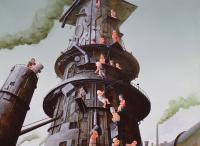 Zhu Zhiwei’s paintings dwell on the incredible scale of China’s industrialization, and the relationship between modern city-dwellers and the man-made environment that they inhabit. In Paradise—Chasing the Wind, factories obscure the horizon. The elongated format and multiple, skewed perspectives of create an intentionally disorienting, fantastical setting. The large central tower seems to be falling apart while it is swarmed by Zhu’s distinctive pink figures. Wearing sunglasses, they climb, dangle and perch on the tower’s nonsensical railings and ledges, creating the impression of an industrial playground. A few characters appear in heroic poses - climbing, carrying objects or helping each other scale the structure. Some sit idly, while others busy themselves pulling pieces off the tower or casting debris downwards. The painting’s lone woman, wearing a qipao (a traditional Chinese dress), dangles her heels, while two men engage in a fistfight down below. On the higher platforms several people. including a man in a red cape, look off into the distance. All appear to be oblivious to rickety state of the tower.
Zhu Zhiwei’s paintings dwell on the incredible scale of China’s industrialization, and the relationship between modern city-dwellers and the man-made environment that they inhabit. In Paradise—Chasing the Wind, factories obscure the horizon. The elongated format and multiple, skewed perspectives of create an intentionally disorienting, fantastical setting. The large central tower seems to be falling apart while it is swarmed by Zhu’s distinctive pink figures. Wearing sunglasses, they climb, dangle and perch on the tower’s nonsensical railings and ledges, creating the impression of an industrial playground. A few characters appear in heroic poses - climbing, carrying objects or helping each other scale the structure. Some sit idly, while others busy themselves pulling pieces off the tower or casting debris downwards. The painting’s lone woman, wearing a qipao (a traditional Chinese dress), dangles her heels, while two men engage in a fistfight down below. On the higher platforms several people. including a man in a red cape, look off into the distance. All appear to be oblivious to rickety state of the tower.
Amidst this flurry of activity, the tower’s purpose remains unclear; the top disappears into a dark, hazy cloud of smoke that drifts across the upper left-hand corner of the composition. The painting’s low vantage point and the strong diagonal lines formed by the tubes on either side of the tower create a disorienting perspective. Viewing the tower from its base, we too can contemplate climbing its dislocated staircases.
Click on the artwork for more information-
$35.00
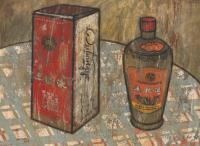 He Jian is notable for his distinctive amalgamation of ancient and contemporary Chinese culture. Rather than painting in oil like most of his contemporaries, he uses rice paper, dry pigment, and binder as his media. He strategically layers and manipulates his paints to assume the timeworn quality of the 14th century Yuan Dynasty frescoes at the Yong Le Temple in Shanxi Province. He Jian uses this distinctive new-old, antiquated style to present a wide range of quotidian subject matter. Although many of his works portray figural groups engaged in activities characteristic of modern Chinese life, in this series He Jian directs his focus towards utilitarian objects that signaled China’s shift towards a consumer culture.
He Jian is notable for his distinctive amalgamation of ancient and contemporary Chinese culture. Rather than painting in oil like most of his contemporaries, he uses rice paper, dry pigment, and binder as his media. He strategically layers and manipulates his paints to assume the timeworn quality of the 14th century Yuan Dynasty frescoes at the Yong Le Temple in Shanxi Province. He Jian uses this distinctive new-old, antiquated style to present a wide range of quotidian subject matter. Although many of his works portray figural groups engaged in activities characteristic of modern Chinese life, in this series He Jian directs his focus towards utilitarian objects that signaled China’s shift towards a consumer culture.
In this painting, He Jian takes the most renowned brand of Chinese grain liquor, Wuliangye, as his subject. Made from a five-crop blend (broomcorn, rice, glutinous rice, wheat, and corn), Wuliangye is known within every household in China but not without, where the stiff liquor has yet to win over drinkers. The liquor in He Jian's painting is depicted with a nostalgic touch, and Wuliangye is a heritage brand as much a part of China's lived history as anything in history books.
Click on the artwork for more information-
$35.00
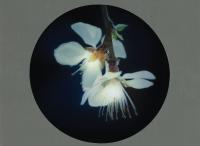 Flawless depicts two pear blossoms in full bloom, suspended from above, with supernatural light emanating from their centers. Yang Xun describes this portrait as “a memory of pure emotion, flawlessly white, but out of reach; where beauty offers hope to soften the pain of longing.” Yang’s Flower series was inspired by Song dynasty flower paintings on round fans. With brilliant light and soft shadow, he uses his subjects to portray multisensory memories of attraction, hope, loneliness or despair.
Flawless depicts two pear blossoms in full bloom, suspended from above, with supernatural light emanating from their centers. Yang Xun describes this portrait as “a memory of pure emotion, flawlessly white, but out of reach; where beauty offers hope to soften the pain of longing.” Yang’s Flower series was inspired by Song dynasty flower paintings on round fans. With brilliant light and soft shadow, he uses his subjects to portray multisensory memories of attraction, hope, loneliness or despair.
Click on the artwork for more information-
$35.00
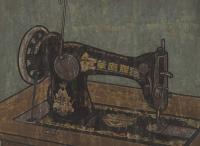 Artist He Jian is notable for his amalgamation of ancient and contemporary Chinese culture. Rather than painting in oil like most of his contemporaries, he uses rice paper, dry pigment, and binder as his media. He strategically layers and manipulates his paints to assume the timeworn quality of the 14th century Yuan Dynasty frescoes at the Yong Le Temple in Shanxi Province. He Jian uses this distinctive new-old, antiquated style to present a wide range of quotidian subject matter. Although many of his works portray figural groups engaged in activities characteristic of contemporary Chinese life, in this series He Jian directs his focus towards some utilitarian objects that signal China’s shift towards a consumer culture. In this painting,
Artist He Jian is notable for his amalgamation of ancient and contemporary Chinese culture. Rather than painting in oil like most of his contemporaries, he uses rice paper, dry pigment, and binder as his media. He strategically layers and manipulates his paints to assume the timeworn quality of the 14th century Yuan Dynasty frescoes at the Yong Le Temple in Shanxi Province. He Jian uses this distinctive new-old, antiquated style to present a wide range of quotidian subject matter. Although many of his works portray figural groups engaged in activities characteristic of contemporary Chinese life, in this series He Jian directs his focus towards some utilitarian objects that signal China’s shift towards a consumer culture. In this painting,
Although potentially unremarkable to Western viewers, the sewing machine has a larger cultural significance in China: during the 70s and 80s, the sewing machine was one of the “three essentials” necessary for a prosperous marriage, and its grade a direct indicator of wealth and status. The goods that comprise the “essentials” have been continually redefined, and thus serve as an indicator of China’s economic development since the mid-20th century. For example, whereas in the 1980s these items were a watch, a bike, and a sewing machine, today they are more likely to include a house, a car, and money for vacation travels. For He Jian and his generation, sewing machines of this sort are familiar household objects from their childhood. His presentation in the style of ancient Chinese frescoes historicizes and romanticizes the sewing machine, and suggests its elevation to the same level as the Taoist deities that line the walls of Yong Le Temple. He Jian's painting melds the style and flavor of ancient China with a subject that heralds its recent history, visualizing the complex dialogue between ancient and contemporary Chinese culture.
Click on the artwork for more information-
$35.00
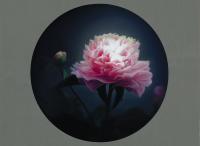 Note: This artwork is not yet available for sale, but will be soon.
Note: This artwork is not yet available for sale, but will be soon.
The Compendium of Materia Medica refers to a 16th-century compendium of medicinal herbs, compiled by Li Shizhen, a Ming Dynasty botanist and pharmacologist. According to the Yang Xun, "Peony was described in the Compendium of Materia Medica as an unambiguously beneficial herb. This medicinal aspect is overlooked because of its exquisite flower; but underneath the ostentatious petals is a staid and reliable character."
Yang’s Flowers series was inspired by Song dynasty flower paintings on round fans. With brilliant light and soft shadow, he uses his subjects to portray multisensory memories of attraction, hope, longing or despair.
Click on the artwork for more information-
$35.00
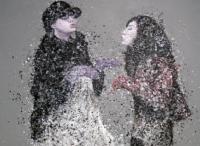 Huang Yuncan’s series New Youth, looks at the transience of youth and the delicate memories it creates. Huang mimics the haziness of recollection with floating spots that coalesce into figures and interactions.
Huang Yuncan’s series New Youth, looks at the transience of youth and the delicate memories it creates. Huang mimics the haziness of recollection with floating spots that coalesce into figures and interactions.
Two women with puckered lips approach one another with awkwardly bent knees and wrists. Their affected air kissing belies a system of social interaction borrowed from elsewhere—are these kisses of greeting, parting, or have they taken on a completely new meaning? In contrast with their parents generation, these members of China’s urban youth sport the latest fashions, Chuck Taylors and sunglasses. With the exception of the women’s flushed faces, the only other items that receive special notice are the purple gloves and red coat, bringing focus to material possessions. Within the mind’s unreliable archives, a superficial detail can come to define a moment.
This moment seems contemporary, but Huang presents it as a memory, begging the question of what the future holds for this generation and its hybrid culture, and more importantly, what it will be remembered for.
Click on the artwork for more information-
$35.00
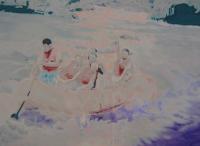 A group of recreationers floats by in fuzzy detail. The expressions on their faces aren't clear, but the lift of their cheeks and the shape of their eyes suggests a carefree abandon to their leisure. Wang Chunli creates the impression of their shapes through fields of pastels, subdued colors juxtaposed to each other in a quiet evocation of the jubilee in the original. Wang Chunli uses both digital and painting techniques to manipulate original source images into their final versions, a mediation that inserts elements of time, texture, and emotion into images even as it strips away their specificity.
A group of recreationers floats by in fuzzy detail. The expressions on their faces aren't clear, but the lift of their cheeks and the shape of their eyes suggests a carefree abandon to their leisure. Wang Chunli creates the impression of their shapes through fields of pastels, subdued colors juxtaposed to each other in a quiet evocation of the jubilee in the original. Wang Chunli uses both digital and painting techniques to manipulate original source images into their final versions, a mediation that inserts elements of time, texture, and emotion into images even as it strips away their specificity.
Click on the artwork for more information-
$35.00
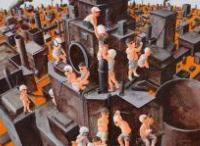 Zhu Zhiwei’s paintings dwell on the incredible scale of China’s industrialization, and the relationship between modern city-dwellers and the man-made environment that they inhabit. In Paradise: The Peak the elongated format and multiple skewed perspectives create an intentionally disorienting, fantastical setting. This sense of dislocation is heightened by the viewer’s aerial perspective, which affords a panoramic view of buildings and smokestacks that extends to the horizon. Both the unnatural orange surface below and the repetition of blackened, factory-like shapes create the impression of an infinite industrial landscape.
Zhu Zhiwei’s paintings dwell on the incredible scale of China’s industrialization, and the relationship between modern city-dwellers and the man-made environment that they inhabit. In Paradise: The Peak the elongated format and multiple skewed perspectives create an intentionally disorienting, fantastical setting. This sense of dislocation is heightened by the viewer’s aerial perspective, which affords a panoramic view of buildings and smokestacks that extends to the horizon. Both the unnatural orange surface below and the repetition of blackened, factory-like shapes create the impression of an infinite industrial landscape.
Zhu’s distinctive pink figures swarm the tiered tower that dominates the center of the composition, and are engaged in a variety of pursuits and activities. Some subjects stand or sit idly, with several of them wearing helmets and wielding metal rods. In the lower half of the painting, a man wearing a cape scales the tower on a rope. Near the top, a group of three figures cooperate to climb to the next tier. One man blows a horn while facing off into the distance, and another beats on the structure with two metal rods. A figure with his bandaged arm in a sling sits perched on a ledge drinking. In the center of the painting is sinister looking scene in which a single prone figure is straddled by a helmeted, knife-wielding figure and surrounded by several others. Nearby, another figure looms menacingly above them with large stick.
Meanwhile, at the top of the tower is a lone woman in a red qipao, or traditional Chinese dress. From her position at the peak, she looks down on the scene below with an expression of concern.
Click on the artwork for more information-
$35.00
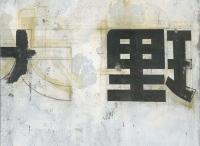 Chen Jiao's Dali depicts the characters for the Chinese city in southwest Yunnan province. It takes a moment to read the characters—the second character is positioned backwards—and they stand out more for their bold form and rich texture than their content, an effect achieved through layering colors and a variety of materials, such as paper, paint, chalk, and blackboard. Chen's use of signage is abstract even as her manipulation of medium creates a very specific effect—Dali has a quality of urban vibrancy about its embrace of the material, allowing a two-dimensional surface to invoke a myriad of social connotations, opening up the abstracted work to many possibilities.
Chen Jiao's Dali depicts the characters for the Chinese city in southwest Yunnan province. It takes a moment to read the characters—the second character is positioned backwards—and they stand out more for their bold form and rich texture than their content, an effect achieved through layering colors and a variety of materials, such as paper, paint, chalk, and blackboard. Chen's use of signage is abstract even as her manipulation of medium creates a very specific effect—Dali has a quality of urban vibrancy about its embrace of the material, allowing a two-dimensional surface to invoke a myriad of social connotations, opening up the abstracted work to many possibilities.
Click on the artwork for more information-
$35.00
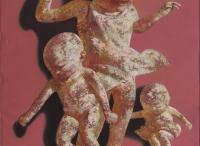 Children are a frequent theme in Guo Jin's work, meditations upon pure joy and unadultered idealism. Jumping catches three children at Henri Cartier-Bresson's “decisive moment,” poised in kinetic potential as they jump mid-air against an abstract pink sky. Their rounded bodies possess a convincing heft, but their skin is spackled in red, yellow, peach, and white, a texture that suggests both materiality, like the surface of marble, and the passage of time, like antiqued painted furniture. Are these children real or allegorical? Where are they leaping to and what are they leaping from? Guo Jin's work gives itself to many different readings, but the children's sense of dynamism and joy remains constant.
Children are a frequent theme in Guo Jin's work, meditations upon pure joy and unadultered idealism. Jumping catches three children at Henri Cartier-Bresson's “decisive moment,” poised in kinetic potential as they jump mid-air against an abstract pink sky. Their rounded bodies possess a convincing heft, but their skin is spackled in red, yellow, peach, and white, a texture that suggests both materiality, like the surface of marble, and the passage of time, like antiqued painted furniture. Are these children real or allegorical? Where are they leaping to and what are they leaping from? Guo Jin's work gives itself to many different readings, but the children's sense of dynamism and joy remains constant.
Click on the artwork for more information-
$35.00
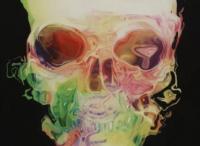 2009-07, is part of larger series based inspired by the the artist’s reflections on death. a large skull is centered on a black background. It is rendered frontally in a shimmering riot of colors, which gives it a psychedelic flavor. Despite its eerie qualities, its atypical, abstracted representation partially removes its deathly associations; the skull’s technicolor, viscous rendering dissolves its outline, which helps to conceal its true nature. However, its deep eye sockets create a vacuum that draws in its viewers, forcing them into a staring match that they cannot hope to win. This frontal depiction is a watery mirror for its audience, and a less than subtle reminder of the inevitability of mortality.
2009-07, is part of larger series based inspired by the the artist’s reflections on death. a large skull is centered on a black background. It is rendered frontally in a shimmering riot of colors, which gives it a psychedelic flavor. Despite its eerie qualities, its atypical, abstracted representation partially removes its deathly associations; the skull’s technicolor, viscous rendering dissolves its outline, which helps to conceal its true nature. However, its deep eye sockets create a vacuum that draws in its viewers, forcing them into a staring match that they cannot hope to win. This frontal depiction is a watery mirror for its audience, and a less than subtle reminder of the inevitability of mortality.
Click on the artwork for more information-
$35.00
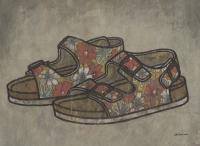 Artist He Jian is notable for his amalgamation of ancient and contemporary Chinese culture. Rather than painting in oil like most of his contemporaries, He Jian uses rice paper, dry pigment, and binder as his media. He strategically layers and manipulates his paints to take on the timeworn quality of the 14th century Yuan Dynasty frescoes at the Yong Le Temple in Shanxi Province. He Jian uses this distinctive new-old, antiquated style to present a wide range of quotidian subject matter. Although many of his works portray figural groups engaged in activities characteristic of contemporary Chinese life, in this series He Jian directs his focus towards utilitarian objects that signal China’s shift towards a consumer culture. In this painting, He Jian depicts a pair of floral sandals. The anachronistic depiction of this footwear suggests its elevation to the same level as the Taoist deities that line the walls of Yong Le Temple. He Jian's painting melds the style and flavor of ancient China with a subject that heralds its recent history, visualizing the complex dialogue between ancient and contemporary Chinese culture.
Artist He Jian is notable for his amalgamation of ancient and contemporary Chinese culture. Rather than painting in oil like most of his contemporaries, He Jian uses rice paper, dry pigment, and binder as his media. He strategically layers and manipulates his paints to take on the timeworn quality of the 14th century Yuan Dynasty frescoes at the Yong Le Temple in Shanxi Province. He Jian uses this distinctive new-old, antiquated style to present a wide range of quotidian subject matter. Although many of his works portray figural groups engaged in activities characteristic of contemporary Chinese life, in this series He Jian directs his focus towards utilitarian objects that signal China’s shift towards a consumer culture. In this painting, He Jian depicts a pair of floral sandals. The anachronistic depiction of this footwear suggests its elevation to the same level as the Taoist deities that line the walls of Yong Le Temple. He Jian's painting melds the style and flavor of ancient China with a subject that heralds its recent history, visualizing the complex dialogue between ancient and contemporary Chinese culture.
Click on the artwork for more information-
$35.00
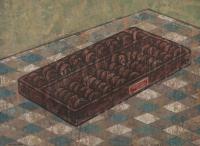 He Jian is notable for his amalgamation of ancient and contemporary Chinese culture. Rather than painting in oil like most of his contemporaries, he uses rice paper, dry pigment, and binder as his media. He strategically layers and manipulates his paints to take on the timeworn quality of the 14th century Yuan Dynasty frescoes at the Yong Le Temple in Shanxi Province. He Jian uses this distinctive new-old, antiquated style to present a wide range of quotidian subject matter. Although many of his works portray figural groups engaged in activities characteristic of modern Chinese life, in this series He Jian directs his focus towards utilitarian objects that signaled China’s shift towards a consumer culture. The cheap electronics that have dominated Chinese manufacturing in the past two decades have all but obliterated use of the abacus, a traditional Asian counting tool. But it was only as recently as the 1990s when virtually every shopkeeper in the mainland used one. In a short span of time, the abacus has already become a forgotten object, and both He Jian's stylistics and subject matter are informed by this nostalgia.
He Jian is notable for his amalgamation of ancient and contemporary Chinese culture. Rather than painting in oil like most of his contemporaries, he uses rice paper, dry pigment, and binder as his media. He strategically layers and manipulates his paints to take on the timeworn quality of the 14th century Yuan Dynasty frescoes at the Yong Le Temple in Shanxi Province. He Jian uses this distinctive new-old, antiquated style to present a wide range of quotidian subject matter. Although many of his works portray figural groups engaged in activities characteristic of modern Chinese life, in this series He Jian directs his focus towards utilitarian objects that signaled China’s shift towards a consumer culture. The cheap electronics that have dominated Chinese manufacturing in the past two decades have all but obliterated use of the abacus, a traditional Asian counting tool. But it was only as recently as the 1990s when virtually every shopkeeper in the mainland used one. In a short span of time, the abacus has already become a forgotten object, and both He Jian's stylistics and subject matter are informed by this nostalgia.
Click on the artwork for more information-
$35.00
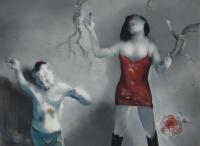 Luo Fahui is part of the generation of artists who studied fine arts shortly after the Cultural Revolution (1966-1976). His oil paintings, which are characterized by surreal, pearly gray composition punctuated by bright splashes of crimson and turquoise, address themes of desire, isolation and violence.
Luo Fahui is part of the generation of artists who studied fine arts shortly after the Cultural Revolution (1966-1976). His oil paintings, which are characterized by surreal, pearly gray composition punctuated by bright splashes of crimson and turquoise, address themes of desire, isolation and violence.
In his painting My Garden, a woman and boyish figure stand in an ambiguous gray space. Red and blue hues interject Luo’s monotone palette, which are most strongly concentrated in the boy’s blue trousers and the woman’s red dress. This short, red dress is the central focus of the composition, and its textural quality establishes it as the singular realistic object in an otherwise surreal setting. However, upon examination, it becomes clear that it is not so much the woman who wears the dress as the dress who wears the woman, becoming the painting’s protagonist. Paired with glistening, knee-high leather boots, this dress has a provocative affect, which challenges its viewers and leaves them acutely aware of their gaze.
The two-dimensionality and emptiness of the setting voids it of time of place, and therein bringing into question the titular “garden.” The only markers of a location are the twisted branches that reach down on either side of the female figure, the faint barbed wire that extends across the painting, and the faint, rose floating in the lower left corner.
The figures’ arms are raised in mirroring poses that echo the branches themselves. While the woman grasps a tree branch on her left and confidently brandishes lipstick in her right hand, the boy stands dejected, wraps his left hand in barbed wire, and bleeds from his right palm.
Click on the artwork for more information-
$35.00
 Chills on a Rainy Night depicts a cluster of pink blossoms against a nighttime backdrop. While the sky appears cold and overcast, a warm and unnatural light emanates from the pistil of the upward facing flower. Yang Xun describes this work as “the melancholy sight of peach blossoms on a rainy night, when long-forgotten memories can trigger a longing for someone who has disappeared from one’s life.” Yang’s Flowers series was inspired by Song dynasty flower paintings on round fans. With brilliant light and soft shadow, he uses his subjects to portray multisensory memories of attraction, hope, longing or despair.
Chills on a Rainy Night depicts a cluster of pink blossoms against a nighttime backdrop. While the sky appears cold and overcast, a warm and unnatural light emanates from the pistil of the upward facing flower. Yang Xun describes this work as “the melancholy sight of peach blossoms on a rainy night, when long-forgotten memories can trigger a longing for someone who has disappeared from one’s life.” Yang’s Flowers series was inspired by Song dynasty flower paintings on round fans. With brilliant light and soft shadow, he uses his subjects to portray multisensory memories of attraction, hope, longing or despair.
Click on the artwork for more information-
Available Soon
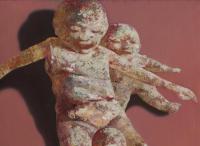 Children are a frequent theme in Guo Jin's work, meditations upon pure joy and unadultered idealism. Sliding captures a group of three moving with grace and abandon down an unseen slide behind them. Their movement is innocent, capturing a moment of play, but when the children are considered as stand-ins for something greater, whether that be society or the state of a country, the painting takes on greater complexities: does the downward slide imply loss or danger, and if so, what is the childrens' agency? Did they initate this descent, or plunge into it unwittingly? Guo Jin's work gives itself to many different readings, but the painting's sense of momentum and unknown potential remains constant.
Children are a frequent theme in Guo Jin's work, meditations upon pure joy and unadultered idealism. Sliding captures a group of three moving with grace and abandon down an unseen slide behind them. Their movement is innocent, capturing a moment of play, but when the children are considered as stand-ins for something greater, whether that be society or the state of a country, the painting takes on greater complexities: does the downward slide imply loss or danger, and if so, what is the childrens' agency? Did they initate this descent, or plunge into it unwittingly? Guo Jin's work gives itself to many different readings, but the painting's sense of momentum and unknown potential remains constant.
Click on the artwork for more information-
$35.00
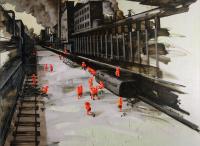 Zhu Zhiwei’s paintings dwell on the incredible scale of China’s industrialization, and the relationship between modern city dwellers and the man-made environment that they inhabit. Paradise: Wrestling depicts an industrial site of gigantic proportions. A long, wide alley is situated between two rows of factory buildings, which all recede into the distance. Despite its large proportions, there is a certain sense of enclosure; thick pillars of smoke clog the sky in the background, and a large walkway in the upper-right corner connects these rows of the buildings.
Zhu Zhiwei’s paintings dwell on the incredible scale of China’s industrialization, and the relationship between modern city dwellers and the man-made environment that they inhabit. Paradise: Wrestling depicts an industrial site of gigantic proportions. A long, wide alley is situated between two rows of factory buildings, which all recede into the distance. Despite its large proportions, there is a certain sense of enclosure; thick pillars of smoke clog the sky in the background, and a large walkway in the upper-right corner connects these rows of the buildings.
The entire composition is saturated by monotonous gray hues, with the sole exception of the neon-orange figures that dot the painting. These small figures further amplify the scene’s enormous scale, and appear engulfed by their industrial surroundings. The action is concentrated to the front right section of the composition, where two figures engage in a wrestling match. Judging by the crowd that encircles them and the photographer in front, the fight is planned rather than spontaneous. Although one spectator raises his arms in what appears to be sincere enthusiasm, the others either watch passively or ignore the scene all together. The purpose or intent of their various activities is quite ambiguous. A sunglasses-wearing figure to the left appears to be destroying discarded pieces of machinery. Slightly behind him is a figure wearing a tire around his waist, which is being inflated by a companion. Meanwhile, a figure towards the back of the composition holds what appears to be a large iron ball, while two others in the distance climb across pieces of machinery.
Perhaps most mysterious of all is the figure that stands on the block in the right corner of the painting; he is distinguishable from his companions by his monkey mask, cape, and staff. These attributes suggest an allusion to the Monkey King—the mischievous hero from the Chinese classical novel Journey to the West. Distanced from the other figures with crossed arms, he seems to survey the games and pursuits of his companions with a sense of superiority.
Click on the artwork for more information-
$35.00
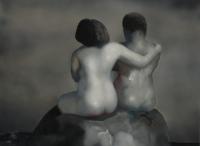 Luo Fahui is part of the generation of artists who studied fine arts shortly after the Cultural Revolution (1966-1976). His oil paintings, which are characterized by surreal, pearly gray composition punctuated by bright splashes of crimson and turquoise, address themes of desire, isolation and violence.
Luo Fahui is part of the generation of artists who studied fine arts shortly after the Cultural Revolution (1966-1976). His oil paintings, which are characterized by surreal, pearly gray composition punctuated by bright splashes of crimson and turquoise, address themes of desire, isolation and violence.
In Looking for Sunrise, a nude couple sits together with their backs to the viewer, facing a vast, grey abyss. The entire composition is comprised of Luo’s distinctive shades of gray, which in obscuring any light or detail, render the scene void of time and space. The color and texture of the setting is echoed in the figures themselves; the is man depicted in dark, gestural brushwork not unlike the mound he sits on, whereas the woman is depicted in soft, luminous grays that are evocative of the vaporous sky she faces. The only element of color in the painting is the faint pastel hues that are smudged across the figures fleshy forms—a daub of pink at the knee, a smudge of blue at the neck, and hint of yellow at the shoulder - imbuing the scene with a glimmer of hope.
Click on the artwork for more information-
$35.00
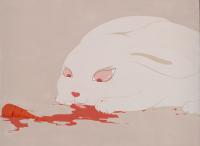 The scene is a gruesome one; a vicious creature with demonic red eyes and sharp claws eagerly laps at a gradually spreading pool of blood. Our gaze follows the trail of blood to the mangled corpse of a poor, defenseless carrot. Breathing a sigh of relief, the viewer quickly realizes that what was initially mistaken for blood is merely carrot juice and the bloodthirsty beast is just an albino bunny innocently enjoying its favorite snack. This mischievous visual duplicity typifies Lili's style and tiptoes playfully on the edge between lighthearted humor and foreboding dread. Her simultaneously cute and creepy animal subjects leave us questioning the difference and relationship between these two extremes.
The scene is a gruesome one; a vicious creature with demonic red eyes and sharp claws eagerly laps at a gradually spreading pool of blood. Our gaze follows the trail of blood to the mangled corpse of a poor, defenseless carrot. Breathing a sigh of relief, the viewer quickly realizes that what was initially mistaken for blood is merely carrot juice and the bloodthirsty beast is just an albino bunny innocently enjoying its favorite snack. This mischievous visual duplicity typifies Lili's style and tiptoes playfully on the edge between lighthearted humor and foreboding dread. Her simultaneously cute and creepy animal subjects leave us questioning the difference and relationship between these two extremes.
Click on the artwork for more information-
$35.00
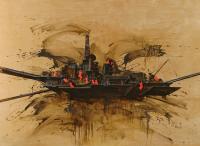 Zhu Zhiwei’s paintings dwell on the incredible scale of China’s industrialization, and the relationship between modern city-dwellers and the man-made environment that they inhabit. Modern Behemoth No. 1 depicts a multi-tiered, abstracted mass of blackened machinery and its twelve orange inhabitants. The wild brushstrokes that surround this structure convey a sense of wild motion and instability, which is reinforced by the viewer’s low vantage point and the cable swinging from the crane on the right. The dripping streams of black paint give a feeling of gravity and oily grime.
Zhu Zhiwei’s paintings dwell on the incredible scale of China’s industrialization, and the relationship between modern city-dwellers and the man-made environment that they inhabit. Modern Behemoth No. 1 depicts a multi-tiered, abstracted mass of blackened machinery and its twelve orange inhabitants. The wild brushstrokes that surround this structure convey a sense of wild motion and instability, which is reinforced by the viewer’s low vantage point and the cable swinging from the crane on the right. The dripping streams of black paint give a feeling of gravity and oily grime.
The twelve cartoonish characters are disproportionately large compared to the cranes and superstructure, but their oversize heads give them an infant-like appearance. They frolic about, while some vandalize machinery with glee. They appear to be unaware of the precarious state of the platform, much less its original purpose. The overall impression is that of an unsupervised industrial playground hurtling wildly through space.
Click on the artwork for more information-
$59.00
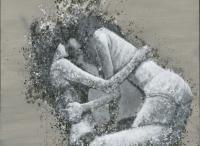 Huang mimics the haziness of recollection with floating spots that coalesce into figures and interactions. Sister is somewhat ambiguous; what at first appears to be a tender moment is steeped in a sense of dread. The figures are rigid in their embrace, and a closer look at their faces reveals expressions of uncertainty. Is this an embrace of affection or solace?
Huang mimics the haziness of recollection with floating spots that coalesce into figures and interactions. Sister is somewhat ambiguous; what at first appears to be a tender moment is steeped in a sense of dread. The figures are rigid in their embrace, and a closer look at their faces reveals expressions of uncertainty. Is this an embrace of affection or solace?
Click on the artwork for more information-
$35.00
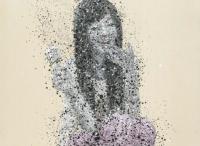 The features of the cheekily smiling girl can barely be seen beneath a veil of heavy black spots. The difficulty in latching on to any one detail mimics the complexity of memory and how it can be clearest when “viewed” peripherally, rather than straight on. The girl has her legs drawn up underneath her, as though she were perched on a seat, but the lack of context makes her appear as a floating apparition. Her fingers brush the bottom of her smiling mouth, as though wiping away dripped ice cream. She relishes her frozen dessert, but seems to enjoy the viewer’s attention even more.
The features of the cheekily smiling girl can barely be seen beneath a veil of heavy black spots. The difficulty in latching on to any one detail mimics the complexity of memory and how it can be clearest when “viewed” peripherally, rather than straight on. The girl has her legs drawn up underneath her, as though she were perched on a seat, but the lack of context makes her appear as a floating apparition. Her fingers brush the bottom of her smiling mouth, as though wiping away dripped ice cream. She relishes her frozen dessert, but seems to enjoy the viewer’s attention even more.
Click on the artwork for more information-
$35.00
 In New Youth Huang invokes nostalgia through memory’s imprecise sketching, and by creating the appearance of a photograph in which the subjects are striking playful, self-conscious poses.
In New Youth Huang invokes nostalgia through memory’s imprecise sketching, and by creating the appearance of a photograph in which the subjects are striking playful, self-conscious poses.
The three girls are grouped together in a single frame, but stand as detached individuals. Their trendy appearance suggests prosperity unknown to previous generations, but offers no insight into what substance lies beneath their youthful fashions. Huang presents her new youth with no visual context, conveying a sense of disconnection.
Click on the artwork for more information-
$35.00
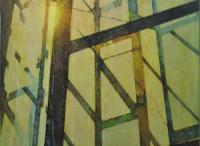 Chen Shijun's distinctive painting style mediates between digital and physical images. The Online Encyclopedia series, for example, takes prosaic images found while browsing online as its source material, and then interprets it through through heavy texturing and a nostalgic palette, converting the raw digital image into a final product with an exceptional sense of physicality. Online Encyclopedia: Daydream, takes an image of late afternoon sun, refracted through a myriad of window panes, as its subject. The painting has a dreamy, nostalgic effect, the sunlight lost in plays of light and shadow just as the mind escapes into absent-minded thought.
Chen Shijun's distinctive painting style mediates between digital and physical images. The Online Encyclopedia series, for example, takes prosaic images found while browsing online as its source material, and then interprets it through through heavy texturing and a nostalgic palette, converting the raw digital image into a final product with an exceptional sense of physicality. Online Encyclopedia: Daydream, takes an image of late afternoon sun, refracted through a myriad of window panes, as its subject. The painting has a dreamy, nostalgic effect, the sunlight lost in plays of light and shadow just as the mind escapes into absent-minded thought.
Click on the artwork for more information-
$35.00
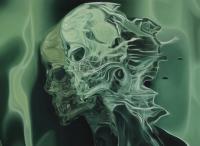 2008.11 depicts an overlapping pair of spectral skulls. It is part of larger series based inspired by the Zheng’s reflections on death. The skulls are shown in profile with their deep, disproportionately large eye sockets facing the to the left. Zheng’s undulating brushwork creates a powerful impression of energy and and motion, complicating subjects’ usual association with mortality. The painting’s monochrome green palette blurs the distinction between the skulls and the background – it is not clear if we are looking at the skulls themselves, or only the ripples in the electrified atmosphere as they fly past us. While their facial outlines are nearly identical, their states of existence appear quite different. In the background, the larger cranium appears static and dark, possibly fading with the passage of time. In contrast, the skull in the foreground is luminous and dynamic; apparently leaving a wake of sparkling, swirling green energy. Is this a portrait of companionship, a progression from past to present, or a contrast of physical and spiritual? The effect is similar to a doubly exposed negative; the two images intimate a photographic progression. This suspension in space and time has made an object of movement itself, leaving its viewers to contemplate the relationship between permanence and transience.
2008.11 depicts an overlapping pair of spectral skulls. It is part of larger series based inspired by the Zheng’s reflections on death. The skulls are shown in profile with their deep, disproportionately large eye sockets facing the to the left. Zheng’s undulating brushwork creates a powerful impression of energy and and motion, complicating subjects’ usual association with mortality. The painting’s monochrome green palette blurs the distinction between the skulls and the background – it is not clear if we are looking at the skulls themselves, or only the ripples in the electrified atmosphere as they fly past us. While their facial outlines are nearly identical, their states of existence appear quite different. In the background, the larger cranium appears static and dark, possibly fading with the passage of time. In contrast, the skull in the foreground is luminous and dynamic; apparently leaving a wake of sparkling, swirling green energy. Is this a portrait of companionship, a progression from past to present, or a contrast of physical and spiritual? The effect is similar to a doubly exposed negative; the two images intimate a photographic progression. This suspension in space and time has made an object of movement itself, leaving its viewers to contemplate the relationship between permanence and transience.
Click on the artwork for more information-
$35.00
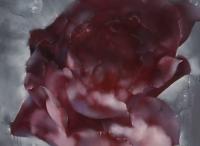 Luo Fahui is part of the generation of artists who studied fine arts shortly after the Cultural Revolution (1966-1976). His oil paintings, which are characterized by surreal, pearly gray composition punctuated by bright splashes of crimson and turquoise, address themes of desire, isolation and violence. While Luo explored landscape in his early career, roses have become a predominant theme in his paintings.
Luo Fahui is part of the generation of artists who studied fine arts shortly after the Cultural Revolution (1966-1976). His oil paintings, which are characterized by surreal, pearly gray composition punctuated by bright splashes of crimson and turquoise, address themes of desire, isolation and violence. While Luo explored landscape in his early career, roses have become a predominant theme in his paintings.
This painting’s composition is quite simple: a large pink rose in full bloom is centered on a square, silver-gray background. However, the complexity of this work comes from its rich, textural, nearly hallucinogenic brushwork. This effect is achieved through a gradual layering of paint, which ultimately results in a thick, tactile quality. The sensuality of his magnified rose suggests the grandiose flowers of Georgia O’Keefe
Click on the artwork for more information-
$35.00
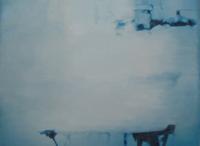 So abstracted is this painting that it is only its title that hints at its original source: The Experience of Reading Vision: Basin No. 11, suggesting that the canvas of light and dark blues depicts a common, every day object, a trough that collects rainwater. Yet how did an image of a phyiscal, tangible, identifiable object become duo-toned abstraction? In order to create the effect, Wang Chunli Select images from daily life, and take pictures for them. The process is an act of reduction, of creating visually manifested difference between the original and its facsimile. Wang Chunli then paints the image that results, a means of both reconstructing the image and tracing preserving the emotional qualities of its degenerative.
So abstracted is this painting that it is only its title that hints at its original source: The Experience of Reading Vision: Basin No. 11, suggesting that the canvas of light and dark blues depicts a common, every day object, a trough that collects rainwater. Yet how did an image of a phyiscal, tangible, identifiable object become duo-toned abstraction? In order to create the effect, Wang Chunli Select images from daily life, and take pictures for them. The process is an act of reduction, of creating visually manifested difference between the original and its facsimile. Wang Chunli then paints the image that results, a means of both reconstructing the image and tracing preserving the emotional qualities of its degenerative.
Click on the artwork for more information-
$35.00
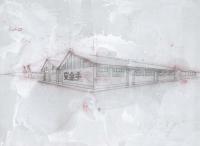 Chen Jiao's November 7th is named after a date, but features an industrial building, sketched lightly against a square grid. More than the building itself, its form stands out against the blank background, with perspective points and the foreground's boundary clearly visible. Against the front building's side, a slogan is available: “safe production,” painted in bold red characters. The final two characters are each drawn backwards, giving a clue that this is image is not actually meant to be a precise rendering of an actual structure. The markings of light color washes are visible in the background, and the work is dotted with Chen's calculations, leaving building measurements and calculations visible. But Chen is no architect. Trained in oil paiting at the Sichuan Fine Art Institute, Chen leaves the calculations visible as a means of voicing the utility and design that goes into the sketch, asking which meanings remain when the building is described in only its signs.
Chen Jiao's November 7th is named after a date, but features an industrial building, sketched lightly against a square grid. More than the building itself, its form stands out against the blank background, with perspective points and the foreground's boundary clearly visible. Against the front building's side, a slogan is available: “safe production,” painted in bold red characters. The final two characters are each drawn backwards, giving a clue that this is image is not actually meant to be a precise rendering of an actual structure. The markings of light color washes are visible in the background, and the work is dotted with Chen's calculations, leaving building measurements and calculations visible. But Chen is no architect. Trained in oil paiting at the Sichuan Fine Art Institute, Chen leaves the calculations visible as a means of voicing the utility and design that goes into the sketch, asking which meanings remain when the building is described in only its signs.
Click on the artwork for more information-
$35.00
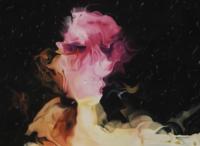 2009-06 is part of a larger series inspired by Zheng’s reflections on desire. In this piece, he pushes the boundaries between abstract expressionism and formalism. At the center of the composition a vaguely human form with outstretched arms divides the black background into four quadrants. This figure is composed, or perhaps engulfed, by colorful, feathery brushwork. These undulating, near-translucent swirls of light and color have a flame-like quality, and seem to rise through the composition. In the black background, bright sparks of of color stream by diagonally. The overall effect is elegant yet ambiguous. Like much of Zheng’s work, this painting communicates a sense of transience. Perhaps the flames are consuming the figure, and its beauty is merely a byproduct of this destruction. Alternatively, it might simply be a coalescence of light and energy in space.
2009-06 is part of a larger series inspired by Zheng’s reflections on desire. In this piece, he pushes the boundaries between abstract expressionism and formalism. At the center of the composition a vaguely human form with outstretched arms divides the black background into four quadrants. This figure is composed, or perhaps engulfed, by colorful, feathery brushwork. These undulating, near-translucent swirls of light and color have a flame-like quality, and seem to rise through the composition. In the black background, bright sparks of of color stream by diagonally. The overall effect is elegant yet ambiguous. Like much of Zheng’s work, this painting communicates a sense of transience. Perhaps the flames are consuming the figure, and its beauty is merely a byproduct of this destruction. Alternatively, it might simply be a coalescence of light and energy in space.
Click on the artwork for more information-
$35.00
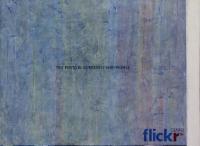 Chen Shijun's distinctive painting style mediates between digital and physical images. The Online Encyclopedia series, for example, takes prosaic images found while browsing online as its source material, and then interprets it through heavy texturing and a nostalgic palette, converting the raw digital image into a final product with an exceptional sense of physicality. Online Encyclopedia: Reality, takes an error message from the website Flickr—a error message reading “This Photo Is Currently Unavailable”—and gives it the texture of a physical artefact. Chen Shijun sources the images in his works from keyword searches on internet search engines, converting the raw image into an oil painting so heavily weathered it seems to bear the mark of time itself.
Chen Shijun's distinctive painting style mediates between digital and physical images. The Online Encyclopedia series, for example, takes prosaic images found while browsing online as its source material, and then interprets it through heavy texturing and a nostalgic palette, converting the raw digital image into a final product with an exceptional sense of physicality. Online Encyclopedia: Reality, takes an error message from the website Flickr—a error message reading “This Photo Is Currently Unavailable”—and gives it the texture of a physical artefact. Chen Shijun sources the images in his works from keyword searches on internet search engines, converting the raw image into an oil painting so heavily weathered it seems to bear the mark of time itself.
Click on the artwork for more information-
$35.00
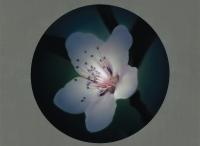 Yang Xun describes this portrait as “a peach blossom appearing from the dark like the scent of perfume left in the street; a visual sensation that reaches the viewer’s subconscious as a fragrance; a mood that gradually fills the air.” Yang’s Flower series was inspired by Song dynasty flower paintings on round fans. With brilliant light and soft shadow, he uses his subjects to portray multisensory memories of attraction, hope, pain, loneliness or despair.
Yang Xun describes this portrait as “a peach blossom appearing from the dark like the scent of perfume left in the street; a visual sensation that reaches the viewer’s subconscious as a fragrance; a mood that gradually fills the air.” Yang’s Flower series was inspired by Song dynasty flower paintings on round fans. With brilliant light and soft shadow, he uses his subjects to portray multisensory memories of attraction, hope, pain, loneliness or despair.
Click on the artwork for more information-
$35.00
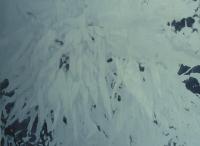 Wang Chunli's The Experience of Reading Vision: Bamboo No. 10 uses a rich turquoise palette to create an evocative image from the silhouette of foliage. Blues, whites, and forest greens are juxtaposed against each other to create the impression of a lush forest, but the image is also abstract enough to be unspecific, suggesting both floral and textile patterns. Wang Chunli uses a simple palette to great effect, layering washes of paint and tone to create depth, and conflating mediums by mixing the effects of photographic source materials with the physicality of paint.
Wang Chunli's The Experience of Reading Vision: Bamboo No. 10 uses a rich turquoise palette to create an evocative image from the silhouette of foliage. Blues, whites, and forest greens are juxtaposed against each other to create the impression of a lush forest, but the image is also abstract enough to be unspecific, suggesting both floral and textile patterns. Wang Chunli uses a simple palette to great effect, layering washes of paint and tone to create depth, and conflating mediums by mixing the effects of photographic source materials with the physicality of paint.
Click on the artwork for more information-
$35.00
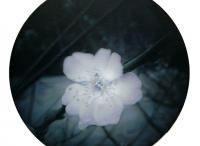 The fresh blossom in A Touch of Plum stands out against a desolate grey background of bare winter branches. While the other portraits Yang Xun's Flowers series all depict a supernatural light shining from the center of their subjects, this early bloomer appears woefully mortal. According to the artist, "The pale pink petals are tender and innocent, but in this desolate scene, seem to have bloomed in vain. This defiant but fragile blossom is bound to inspire hope for an early Spring." Yang’s Flowers series was inspired by Song dynasty flower paintings on round fans. With brilliant light and soft shadow, he uses his subjects to portray multisensory memories of attraction, hope, longing or despair.
The fresh blossom in A Touch of Plum stands out against a desolate grey background of bare winter branches. While the other portraits Yang Xun's Flowers series all depict a supernatural light shining from the center of their subjects, this early bloomer appears woefully mortal. According to the artist, "The pale pink petals are tender and innocent, but in this desolate scene, seem to have bloomed in vain. This defiant but fragile blossom is bound to inspire hope for an early Spring." Yang’s Flowers series was inspired by Song dynasty flower paintings on round fans. With brilliant light and soft shadow, he uses his subjects to portray multisensory memories of attraction, hope, longing or despair.
Click on the artwork for more information-
$35.00
 Note: This artwork is not yet available for sale, but will be soon.
Note: This artwork is not yet available for sale, but will be soon.
Deeply affected by traditional Chinese culture and imagery, Yang Xun’s body of work often draws its inspiration from the world of Chinese gardens, Chinese opera as well as the iconographic patterns of moon-shaped flower paintings dating back to the Song Dynasty. Rays of light, another leitmotif of Yang’s oeuvre, shine from the heart of the compositions of the artist, unfolding in front of the viewer and blooming like fireworks imbued with a transient yet extraordinary beauty.
Yang’s Flowers series was inspired by Song dynasty flower paintings on round fans. With brilliant light and soft shadows, he uses his subjects to portray multisensory memories of attraction, hope, pain and despair. Describing Peach Mystery of Love, Yang says "The sumptuous pink peach blossom is a portrait of femininity. In the patches of light and shadow there is an air of irresistible mystery that lures the viewer into reverie."
Click on the artwork for more information-
$35.00
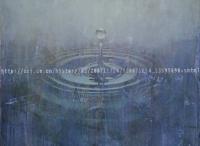 Chen Shijun's distinctive painting style mediates between digital and physical images. The Online Encyclopedia series, for example, takes prosaic images found while browsing online as its source material, and then interprets it through through heavy texturing and a nostalgic palette, converting the raw digital image into a final product with an exceptional sense of physicality. Online Encyclopedia: Obsessive-Compulsive Disorder, takes an image of a water droplet and its ripples, the sort of commercial photograph that comes preinstalled as a background image on many computers, as its point of departure. The perfect unbroken color fields of the original become wrinkled and worn, while an overlaid http address suggests a sense of artificiality.
Chen Shijun's distinctive painting style mediates between digital and physical images. The Online Encyclopedia series, for example, takes prosaic images found while browsing online as its source material, and then interprets it through through heavy texturing and a nostalgic palette, converting the raw digital image into a final product with an exceptional sense of physicality. Online Encyclopedia: Obsessive-Compulsive Disorder, takes an image of a water droplet and its ripples, the sort of commercial photograph that comes preinstalled as a background image on many computers, as its point of departure. The perfect unbroken color fields of the original become wrinkled and worn, while an overlaid http address suggests a sense of artificiality.
Click on the artwork for more information-
$35.00
 Chen Shijun's distinctive painting style mediates between digital and physical images. The Online Encyclopedia series, for example, takes prosaic images found while browsing online as its source material, and then interprets it through through heavy texturing and a nostalgic palette, converting the raw digital image into a final product with an exceptional sense of physicality. Online Encyclopedia: Disaster, takes as its source material a screen capture of an image search result on a Chinese search machine, showing the iconic photograph of the Hindenberg burning in mid-air. The famous photograph has become ubiquitous, popping up in searches for the word “disaster,” and here Chen Shijun gives the photograph a sense of its age by instilling the painting with rich texture and wear.
Chen Shijun's distinctive painting style mediates between digital and physical images. The Online Encyclopedia series, for example, takes prosaic images found while browsing online as its source material, and then interprets it through through heavy texturing and a nostalgic palette, converting the raw digital image into a final product with an exceptional sense of physicality. Online Encyclopedia: Disaster, takes as its source material a screen capture of an image search result on a Chinese search machine, showing the iconic photograph of the Hindenberg burning in mid-air. The famous photograph has become ubiquitous, popping up in searches for the word “disaster,” and here Chen Shijun gives the photograph a sense of its age by instilling the painting with rich texture and wear.
Click on the artwork for more information-
$35.00
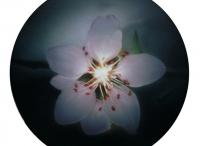 Scarlet in the Shadows depicts a peach blossom in full bloom. The petals, alluring and delicate, draw the viewer in towards the the menacing stamens and blinding light that emanate from the center of the painting. Yang Xun’s Flowers series was inspired by Song dynasty flower paintings on round fans. With brilliant light and soft shadows, he uses his subjects to portray multisensory memories of attraction, hope, pain and despair.
Scarlet in the Shadows depicts a peach blossom in full bloom. The petals, alluring and delicate, draw the viewer in towards the the menacing stamens and blinding light that emanate from the center of the painting. Yang Xun’s Flowers series was inspired by Song dynasty flower paintings on round fans. With brilliant light and soft shadows, he uses his subjects to portray multisensory memories of attraction, hope, pain and despair.
Click on the artwork for more information-
$35.00








